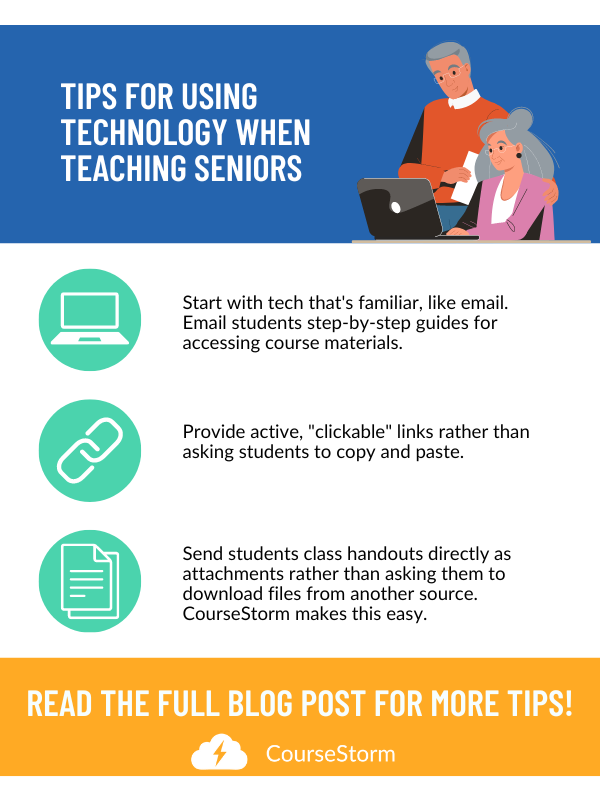Grow Your Program
How To's
6 Tips for Teaching Tech to Older Learners

The pandemic triggered a boom in online classes. More programs added online learning, and for many, virtual classes are here to stay. This offers convenience and accessibility for learners, but some—including seniors—may feel left behind by newer technology. Figuring out how to teach technology to seniors now seems more important than ever.
Programs don’t want seniors to miss out on learning opportunities, but sometimes computer-based learning really is the best choice. To help find a solution, we turned to former CourseStormer Chris Suggs. Chris taught basic computing to older adults as an AmeriCorps volunteer. He shared six thoughtful tips on how to teach technology to seniors.
Seniors and Technology
Before we jump into Chris’s advice, let’s talk more generally about seniors and technology. First, it’s important to recognize that some seniors are perfectly comfortable with technology. For example, a recent Pew survey found that 61% of people aged 65 and older own a smartphone.
Those who do need a little more support may feel intimidated when they have to learn new technology. They may worry about internet safety or giving out personal information online. Some might even feel like all of these digital technologies are unnecessary. A first step might be to explain the relevance of new tools or help them push through self-doubt.
How to Teach Technology to Seniors
These six tips will help you support seniors learning technology. They can work whether you’re teaching a class on using digital devices or are using digital tools for a class on another topic.
1. Start With Technology Seniors Already Know
People learn by connecting new information with information they already know. So, start with technology students already know how to use. For example, most students know how to open an email. Starting with well-known tools can help them build confidence.

Here’s a description of how to add attachments in CourseStorm as well as a short video that shows you how.
If you know learners have used Facebook Live or YouTube, consider using one of those services to present your class, rather than an unfamiliar system. A video accessed with a link is always easier than a service that requires a log in.
2. Simplify Your Software Choices
Consistency helps all learners, no matter their age. “If you have multiple teachers using a variety of platforms in your program—Zoom, WebEx, Google Meets—there’s potentially a lot to learn about,” says Chris.
Sticking with one tool will make life easier for your students. It also means you only have to get comfortable with troubleshooting one type of software. Fortunately, most software providers offer how-to articles and video tutorials. You can use these yourself or share them with your students.
Pay attention to the accessibility options for the software you choose. Seniors are more likely to experience vision and hearing impairments, so accommodations may be extra important.
3. Start With a Technology Orientation Session
The first class of the session could be devoted entirely to getting to know the programs you’ll use in the class. If your learners are unfamiliar with your learning platform, introduce it using a more common program.
Chris suggests answering some of the questions people may not think to ask. For example, “How can I log back on if I get disconnected?” Students also need to know how they can ask questions during class, access handouts or other materials, and communicate with each other. Encourage students to write down these directions since writing improves memory.
4. Make Classes for Seniors a Little Smaller
Smaller classes let you provide more one-on-one support to people who may be uncomfortable with technology. Fewer students mean you have more time for questions and can spend more time answering each one. You can also more easily customize the class for what each student needs.
5. Build in Support for Senior Learners
Review important features at the start of each class like how to mute and unmute, ask questions, and access important tools. Taking an extra few minutes at the start of each class can help students avoid frustration. You can also partner less-confident learners with more tech-savvy peers who can help them during the class.
6. Offer Free Technology “How-To” Classes
Many community education organizations (and others) have found that offering a few free classes has helped boost their overall attendance in paid classes. Offering free technology classes helps your learners become more familiar with the tools your program uses, which means they’re more likely to register for upcoming classes.
“These are opportunities to build the trust of your audience and build up your community,” notes Chris.
Becoming more comfortable with technology has other benefits for seniors as well. They can use their new skills to access telemedicine, communicate with friends and family online, or start experimenting with social media.
One Thing to Remember When Teaching Technology to Seniors
At a time when seniors are more likely to experience social isolation and loneliness, technology can help seniors stay connected. It offers a potentially new outlet for social networking and helps them feel empowered. That’s why helping seniors build their technology skills is so important.
But teaching your senior students in an impactful way can be a challenge. “Compassion is at the heart of it, and patience,” said Chris. “If there are problems, it can be important to just listen.”
Helping senior students get comfortable with technology benefits them, your program, and your community. Here’s one last tip before we finish: make class registration simple with CourseStorm. CourseStorm’s impossibly simple class registration software makes it easy for anyone to find and register for your classes. Start your free trial today or contact us to get started.

Brian Rahill
Brian is a scientist-turned-education technology executive. He has founded and led technology companies for more than 20 years and uses his analytical mind and experimental approach to spur growth in small and medium businesses and start-ups. He is passionate about using technology to enhance access to lifelong learning.
